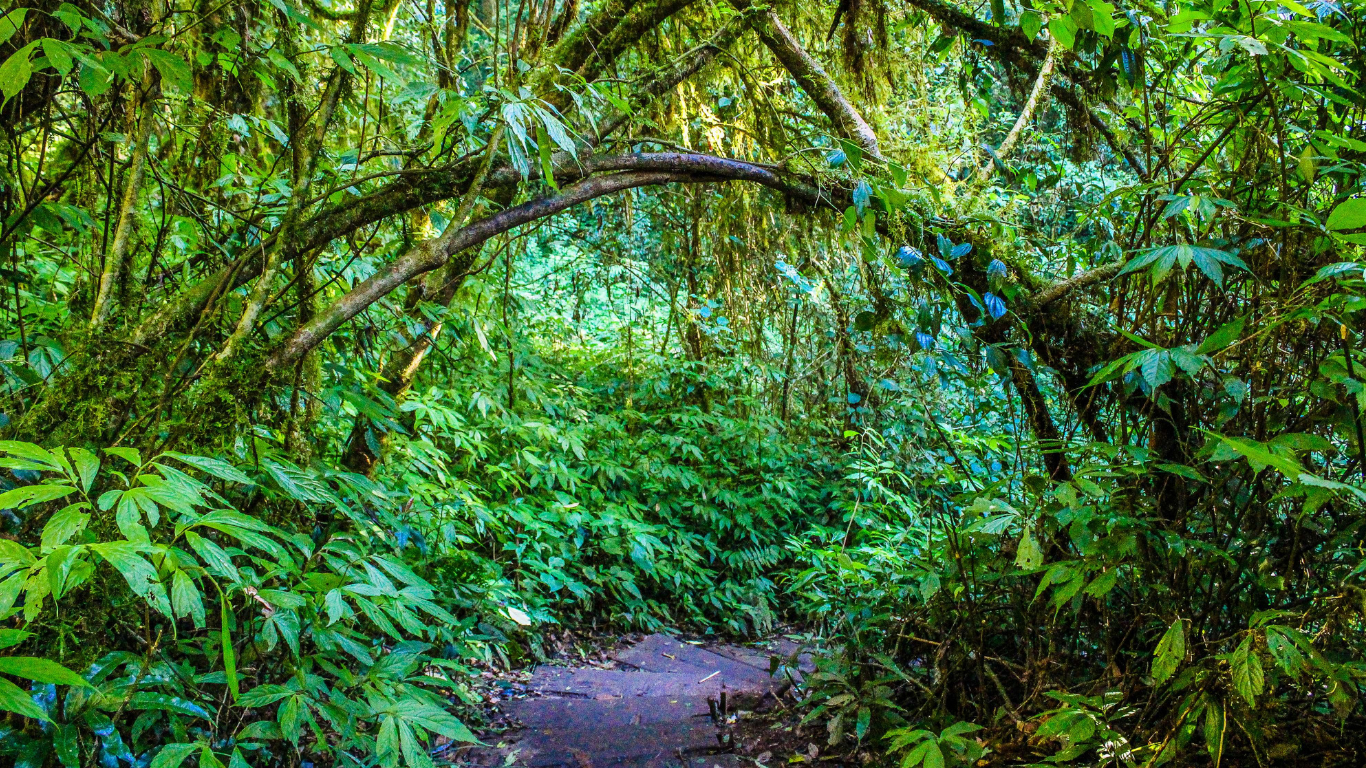Step into the steamy, shadowy depths of a rainforest, where the air hums with life and danger lurks in the most unexpected places. Among the towering trees and vibrant orchids, a group of botanical predators thrives—rainforest carnivorous plants. These mesmerizing killers, with their jaw-dropping traps and cunning strategies, are nature’s own horror show, luring, trapping, and devouring unsuspecting prey. Whether you’re a plant enthusiast in India, a curious gardener in the USA, or a traveler seeking the wild wonders of tropical jungles, this 3000-word guide will plunge you into the thrilling world of rainforest carnivorous plants. From Venus flytraps to pitcher plants, we’ll uncover their secrets, their survival tactics, and their vital role in fragile ecosystems, all with a sensational yet educational flair.
What Are Rainforest Carnivorous Plants?
Carnivorous plants are botanical marvels that have evolved to capture and digest prey—primarily insects, but sometimes small vertebrates like frogs—to supplement their nutrient intake. In the nutrient-poor soils of rainforests, where competition for resources is fierce, these plants have turned to carnivory to survive. Found in tropical rainforests across Southeast Asia, South America, and parts of Africa, rainforest carnivorous plants use specialized traps like sticky surfaces, snap traps, or fluid-filled pitchers to ensnare their victims.
Unlike typical plants that rely solely on photosynthesis, carnivorous plants derive nitrogen, phosphorus, and other nutrients from their prey, giving them a competitive edge in harsh environments. With over 700 species worldwide, from the iconic Venus flytrap to the exotic Nepenthes rajah, these plants are as diverse as they are deadly.
Why Are Rainforest Carnivorous Plants Sensational?
Imagine a plant that lures a fly with sweet nectar, only to snap shut in a fraction of a second, trapping its prey in a leafy prison. Or picture a pitcher plant with a trap so deep and slippery that even a rat can’t escape its watery doom. Rainforest carnivorous plants are nature’s masterminds, blending beauty, deception, and predation in a spectacle that rivals any thriller. Their ability to thrive in extreme conditions and their role in balancing ecosystems make them nothing short of awe-inspiring.
The Importance of Rainforest Carnivorous Plants
Carnivorous plants are more than just botanical curiosities—they’re ecological superheroes with a profound impact on their habitats and beyond. Here’s why they matter:
1. Nutrient Cycling in Poor Soils
Rainforest soils, especially in tropical regions like Borneo, are often leached of nutrients due to heavy rainfall. Carnivorous plants like Nepenthes trap insects to access nitrogen and phosphorus, recycling these nutrients into the ecosystem and supporting nearby flora.
Example: Nepenthes in Borneo
In Borneo’s heath forests, Nepenthes bicalcarata’s pitchers provide nutrients to surrounding mosses, creating microhabitats that boost biodiversity.
2. Pest Control
By preying on insects like mosquitoes and flies, carnivorous plants act as natural pest controllers, reducing populations of disease-carrying species in rainforests.
Example: Sundews in the Amazon
Drosera species in the Amazon use sticky tentacles to trap gnats, helping regulate insect populations near water sources.
3. Biodiversity Hotspots
Carnivorous plants create unique microecosystems. Pitcher plants, for instance, host aquatic organisms like mosquito larvae or even symbiotic crabs, fostering biodiversity within their traps.
Example: Pitcher Plant Symbiosis
Nepenthes rajah in Malaysia supports a tiny ecosystem of bacteria, insects, and even a crab species that lives inside its pitchers, showcasing nature’s interconnectedness.
4. Scientific Inspiration
These plants inspire research in biology, chemistry, and biomimicry. Their enzymes could lead to new medicines, while their trap mechanisms influence robotics and engineering.
Example: Venus Flytrap Robotics
Scientists at Harvard study the Venus flytrap’s snap trap to design fast-closing robotic grippers, blending nature and technology.
5. Conservation Indicators
As sensitive species, carnivorous plants signal ecosystem health. Their decline often warns of habitat degradation, urging conservation action.
Example: Pitcher Plants in Sumatra
The loss of Nepenthes aristolochioides in Sumatra due to deforestation highlights the urgent need to protect rainforest habitats.
Iconic Rainforest Carnivorous Plants: Meet the Predators
Let’s venture into the jungle to meet five of the most captivating carnivorous plants, each with its own deadly charm and rainforest home.
1. Venus Flytrap (Dionaea muscipula)
Though native to subtropical wetlands, Venus flytraps thrive in rainforest-like conditions in cultivation. Their snap traps, triggered by tiny hairs, close in 0.1 seconds to trap insects. Found in experimental rainforest gardens in India, they’re a favorite for enthusiasts.
2. Pitcher Plants (Nepenthes spp.)
Nepenthes, or tropical pitcher plants, dominate Southeast Asian rainforests like Borneo and Sumatra. Their fluid-filled pitchers, some as large as a football, drown prey in digestive enzymes. Nepenthes rajah, the largest, can hold 3.5 liters of liquid and trap small mammals.
3. Sundews (Drosera spp.)
Sundews, with their glistening, sticky tentacles, are found in South American and African rainforests. Drosera regia in South Africa curls its leaves around prey, digesting insects with enzymes in hours.
4. Bladderworts (Utricularia spp.)
These aquatic or semi-aquatic plants, common in Amazonian rainforests, use tiny bladder traps to suck in microscopic prey like water fleas. Utricularia gibba’s traps work in milliseconds, making them the fastest carnivorous plants.
5. Butterworts (Pinguicula spp.)
Butterworts, found in Central American rainforests, use sticky, flypaper-like leaves to trap gnats. Pinguicula gigantea in Mexico digests prey with enzymes, leaving only exoskeletons behind.
Example: Nepenthes rajah’s Rat Trap
In Borneo, a Nepenthes rajah pitcher was found with a drowned rat, showcasing its ability to tackle large prey and thrilling researchers studying its digestive enzymes.
How Carnivorous Plants Work: The Art of Predation
Carnivorous plants have evolved five main trap types, each a masterpiece of adaptation:
1. Snap Traps
Used by Venus flytraps, these traps close rapidly when trigger hairs are touched twice, ensuring only live prey is caught. The trap digests the prey over days before reopening.
2. Pitfall Traps
Nepenthes pitchers lure prey with nectar, then trap them in slippery, enzyme-filled pools. Some, like Nepenthes bicalcarata, have fangs to deter mammals from stealing prey.
3. Flypaper Traps
Sundews and butterworts use sticky mucilage to ensnare insects. Enzymes break down the prey, and nutrients are absorbed through the leaves.
4. Suction Traps
Bladderworts’ underwater bladders create a vacuum, sucking in prey when triggered. This rapid mechanism thrives in rainforest streams.
5. Lobster-Pot Traps
Rarely seen in rainforests, these traps (e.g., Genlisea) use spiral tunnels to guide prey toward digestive chambers.
Example: Sundew’s Sticky Show
In a Brazilian rainforest, a Drosera spatulata was observed trapping a mosquito in its sticky tentacles, curling its leaf to maximize digestion—a slow-motion drama visible to hikers.
Habitats of Rainforest Carnivorous Plants
Carnivorous plants thrive in specific rainforest niches where nutrients are scarce:
- Heath Forests: Low-nutrient, acidic soils in Borneo host Nepenthes, which climb trees to access sunlight.
- Peat Swamps: Waterlogged Amazonian swamps support bladderworts and sundews, which tolerate flooding.
- Montane Rainforests: High-altitude forests in Malaysia nurture Nepenthes rajah, adapted to cool, misty conditions.
- Epiphytic Niches: Some Nepenthes grow on trees, capturing insects and rainwater in their pitchers.
Example: Kinabalu’s Pitcher Paradise
Mount Kinabalu in Malaysia, a UNESCO site, is a hotspot for Nepenthes, with species like Nepenthes villosa thriving in misty montane forests, drawing botanists and adventurers.
Growing Rainforest Carnivorous Plants: Tips for Enthusiasts
Fascinated by these predators? You can grow them at home, whether in India, the USA, or beyond. Here’s how:
1. Mimic Their Habitat
Use peat moss and perlite (1:1) for soil, keeping it moist but not waterlogged. Maintain high humidity (70-90%) and temperatures of 20-30°C for tropical species.
2. Provide Light
Nepenthes and sundews need 12-16 hours of bright, indirect light. In India, place them near east-facing windows; in the USA, use grow lights during winter.
3. Water Wisely
Use distilled or rainwater to avoid mineral buildup. Keep soil damp, but avoid standing water for Venus flytraps.
4. Feed Sparingly
If insects are scarce, feed small flies or rehydrated bloodworms monthly. Overfeeding harms plants.
5. Avoid Common Pitfalls
Don’t use tap water or fertilizers, and avoid triggering Venus flytrap traps unnecessarily—it weakens them.
Example: A Mumbai Grower’s Success
In Mumbai, a hobbyist grew Nepenthes alata in a terrarium with LED lights, mimicking Borneo’s humidity. The plant produced vibrant pitchers, inspiring local plant clubs.
Challenges Facing Rainforest Carnivorous Plants
These botanical wonders face existential threats:
1. Habitat Destruction
Deforestation in Sumatra and Borneo destroys Nepenthes habitats. Over 30% of Indonesia’s rainforests were lost between 1990 and 2010.
2. Climate Change
Rising temperatures and altered rainfall disrupt rainforest microclimates, stressing sensitive species like Nepenthes rajah.
3. Illegal Poaching
Rare plants like Nepenthes rajah are poached for collectors, threatening wild populations. Malaysia’s fines of $2,000 deter but don’t eliminate the issue.
4. Invasive Species
Non-native plants and animals disrupt rainforest ecosystems, competing with carnivorous plants for resources.
5. Limited Awareness
Many remain unaware of these plants’ ecological value, hindering conservation efforts.
Example: Sumatra’s Loss
Nepenthes aristolochioides, once abundant in Sumatra, is critically endangered due to logging, with fewer than 50 plants left in the wild.
Conservation Efforts: Saving Nature’s Predators
Global initiatives are fighting to protect carnivorous plants:
- Protected Areas: Kinabalu National Park in Malaysia safeguards Nepenthes habitats.
- Ex-Situ Conservation: Botanic gardens like Kew cultivate rare species for reintroduction.
- Community Engagement: Indigenous groups in Borneo monitor poaching, preserving cultural and ecological heritage.
- Research and Awareness: Organizations like the International Carnivorous Plant Society fund studies and educate the public.
Example: Kew’s Seed Bank
Kew Gardens in the UK stores Nepenthes seeds, ensuring species like Nepenthes rajah survive even if wild populations vanish.
How You Can Support Rainforest Carnivorous Plants
You can be a champion for these plants:
1. Grow Responsibly
Buy from reputable nurseries, not wild-collected plants, to reduce poaching.
2. Support Conservation
Donate to groups like the IUCN or volunteer at botanic gardens.
3. Spread Awareness
Share photos and facts on social media with #CarnivorousPlants to inspire others.
4. Advocate for Rainforests
Support policies protecting tropical forests, like Brazil’s Amazon initiatives.
5. Visit Ethically
Explore rainforest parks but follow guidelines to avoid harming plants.
Tips for Exploring Rainforest Carnivorous Plants: For India, USA, and Travelers
Ready to witness these predators in their natural glory or in cultivation? Here’s how to plan an unforgettable experience:
- Research Destinations: In India, visit botanical gardens like Kolkata’s Acharya Jagadish Chandra Bose Garden, which cultivates Nepenthes. In the USA, explore the Atlanta Botanical Garden’s carnivorous plant collection. Travelers, head to Borneo’s Kinabalu National Park for wild Nepenthes.
- Dress for the Jungle: Wear breathable, long-sleeved clothing and sturdy boots for India’s humid gardens or Borneo’s trails. In the USA, layer up for indoor conservatories. Bring insect repellent for wild adventures.
- Bring Gear: Carry a magnifying glass to inspect sundew tentacles or pitcher rims. A camera captures vibrant traps. Travelers, pack a universal adapter for charging devices.
- Respect Nature: Stay on trails to avoid crushing plants, especially in Borneo’s fragile heath forests. Don’t touch or collect specimens.
- Engage with Experts: Join guided tours in Kinabalu or Atlanta to learn about trap mechanisms and conservation. Ask about local species like Drosera in India.
Example: A Traveler’s Borneo Quest
A German botanist trekked Kinabalu National Park, spotting Nepenthes rajah’s massive pitchers. Guided by a local ranger, they learned about symbiotic crabs, sharing the experience on Instagram with #RainforestPlants, boosting park tourism.
The Future of Rainforest Carnivorous Plants
The future holds promise and peril for these plants:
- Biotech Breakthroughs: Enzyme research could yield new drugs, as seen in preliminary Nepenthes studies.
- Climate Adaptation: Breeding resilient hybrids may help plants survive warming climates.
- Global Networks: The IUCN’s Red List tracks threatened species, guiding conservation.
- Eco-Tourism Growth: Responsible tourism in Borneo funds habitat protection.
Example: Singapore’s Conservation Model
Singapore’s Gardens by the Bay cultivates Nepenthes and educates millions, funding rainforest conservation and inspiring global efforts.
Conclusion: Embrace the Deadly Allure
Rainforest carnivorous plants are nature’s most captivating predators, weaving beauty, deception, and survival into every trap. From Borneo’s Nepenthes rajah to the Amazon’s sundews, this 3000-word journey has revealed their ecological importance, stunning diversity, and urgent need for protection. They recycle nutrients, control pests, and inspire science, all while battling deforestation and climate change.
Join their story today—grow a Venus flytrap, visit a rainforest, or share this guide with #CarnivorousPlants. Every action helps preserve these deadly beauties for future generations. Let’s ensure their predatory legacy thrives in the wild and in our hearts.




